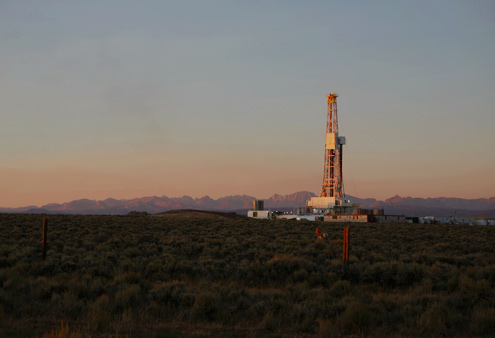Podcast: Play in new window | Download
Subscribe: RSS

In the midst of a natural gas “boom,” fracking rigs like this are fast becoming an endangered species. The reason? Mathematics.
There are three kinds of people in this world: the kind who understand mathematics, and the kind who don’t (Irony alert). You can find the latter buying lottery tickets, leaning over casino tables and conducting news conferences about the new American oil boom. It has become conventional wisdom (oxymoron alert), an assertion not even worthy of discussion by Serious People, that the United States is, as an NPR program host said offhandedly the other day, “on its way to energy independence.” Here’s what mathematics has to say about this titanic (metaphor alert) scam.
- According to reporting by one of the top oil- and gas- patch service companies, Baker Hughes, the number of natural gas drilling wells operating in the United States as of February 8 totaled 425. Four and a half years ago there were over 1600. Using mathematics, please explain how a 75 per cent decline in operating rigs constitutes a boom that can, as the President of the United States said recently, supply America for 100 years.
- According to new study (Drill, Baby, Drill, by Canadian oil and gas geologist J. Dave Hughes) just released by the Post Carbon Institute, production from existing US shale-gas fields is declining by 30-50% every year. New wells must be drilled to replace the ones playing out — an individual well declines by 80-95% in 36 months. According to mathematics, just maintaining current natural gas production will require the drilling of 7,200 new wells every year, at a cost of $42 billion annually. The value of all the shale gas produced in 2012 was $33 billion. And the initial stampede has oversupplied the market, driving retail natural-gas prices below the cost of production. Using mathematics, explain…oh, never mind.
- The numbers for the shale oil boom are equally depressing. On average, a well in the Bakken or Eagle Ford field (the only two basins enjoying the current “boom”) is 80-90% played out in just 24 months, and 40% of production has to be replaced every year just to stay even.
- Another study, Shale Gas and Wall Street, by a former Wall Street analyst, Deborah Rogers, helps explain why the American public has been hit with an avalanche of propaganda about a new oil and gas boom. It has originated, apparently, with the same people who sold us on the new housing boom (Remember? “The price of real estate will never go down?”) and before that the dot-com boom and before that the Enron-ron-ron electricity boom. Wall Street financiers have been bundling oil and gas leases like they used to bundle mortgages, throwing money at drillers like they used to throw it at teenaged dot-com entrepreneurs (that’s a French term, meaning “between jobs”), and using their limitless media budgets to sucker the lamestream media and through them, us. In Rogers’s words, “the recent natural gas market glut was largely effected through overproduction of natural gas in order to meet financial analyst’s production targets and to provide cash flow to support operators’ imprudent leverage positions.”
Mathematics tells us clearly that there is no oil and gas boom. There is an oil and gas bubble, and it is about to burst.
I very recently came across at YouTube one of those people who belong to the third category (irony alert). He seriously believed that the arithmetic of exponential growth doesn’t apply to the real world and that Prof Albert Bartlett (whom I assume you know) was an ‘egghead’ who knew nothing beyond the walls of his academic cloister. He also opined that the fact that no crash has taken place so far already invalidates all the warnings given by Kunstler, Bartlett etc.